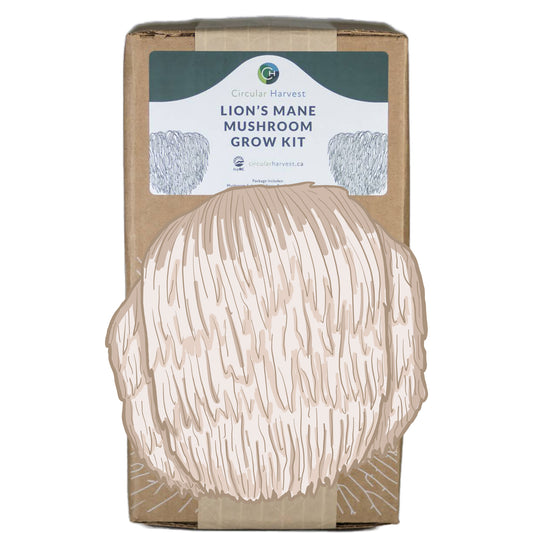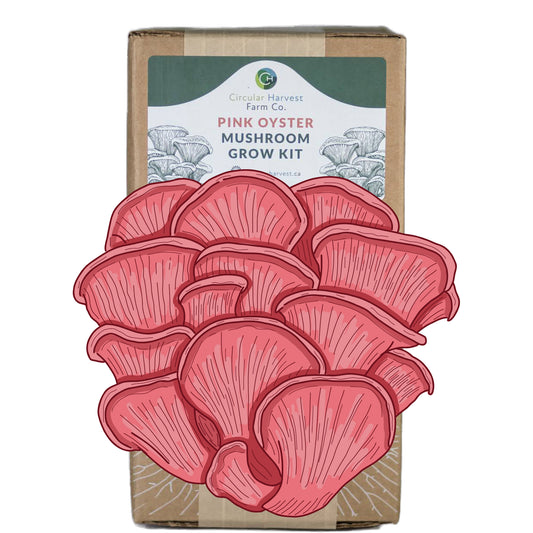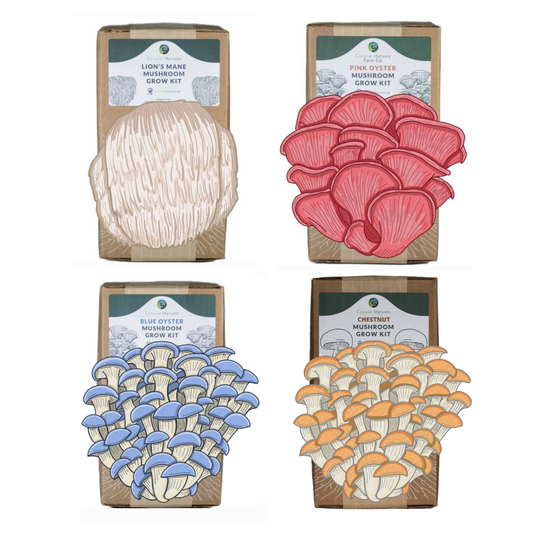The realm of mushroom cultivation, whether pursued as a passionate hobby or a flourishing business, continues to thrive. Central to the art of cultivating mushrooms is the creation of premium grain spawn. This indispensable substance acts as the backbone of mushroom growth. In this comprehensive guide, We'll delve into the various methods to produce grain spawn. We will examine their suitability and offer step-by-step recipes for preparing them. Additionally, we will discuss sustainable grain sourcing and explore the contention surrounding the claim that rye is the gold standard, introducing alternative viewpoints.
Grasping the Significance of Grain Spawn
Before we dive into the nitty-gritty of grain spawn, let's underscore its vital role in mushroom cultivation. Grain spawn, essentially grains colonized by mushroom mycelium, serves as a critical ingredient in the growth process of mushrooms. Grain spawn boasts numerous advantages:
-
Uniform Growth: Grain spawn guarantees uniformity and consistency in the colonization process of your bulk substrate, rendering results more predictable and dependable.
-
Time Efficiency: Employing grain spawn significantly reduces the time needed for mushroom growth compared to spore-based methods. Grains are highly nutritious which boosts mycelial growth and can then be broken up for efficient colonization of the bulk substrate.
-
Diminished Contamination Risk: When prepared diligently, grain spawn holds a lower risk of contamination, providing a stable foundation for mushroom development. Having the intermediate step of grain before moving mycelium to substrate allows for you to also see if your cultures were contaminated. In our experience, majority of the time grain gets contaminated it is due to the culture that was being used to inoculate it.
Now, let's explore various grains often employed for grain spawn production and assess their suitability, accompanied by detailed recipes specifying the amount of grain, water, and any required additives.
Ranking Grains for Grain Spawn
1. Rye Berries
Rye berries are often regarded as an excellent choice for crafting grain spawn due to their tried-and-true performance. However, it's essential to consider that the claim of rye being the gold standard is not universally accepted, particularly in recent light of white millet and oats becoming more prevelant. Rye grain is known to have molds that are hard to kill during sterilization which can lead to contamination issues with your spawn.
Rye Berry Recipe:
Ingredients:
- 5 cups of rye berries
- Sufficient water for soaking (inch above like rice)
- Gypsum (optional, for improved moisture control)
Step-by-Step Preparation:
-
Selection: Opt for whole, unprocessed rye berries, excluding cracked or damaged grains.
-
Rinse, Soak & Drain: Rinse the rye berries meticulously to remove dust and debris. Soak them in clean water for 12-24 hours to ensure thorough hydration. Once hydrated drain off excess moisture and let the outsides dry. Add your gypsum or micronutrients now if desired.
-
Sterilize: After draining, put grains in your container and pressure cooker at 15 PSI for 90 minutes.
-
Cool: Allow them to cool to room temperature before inoculating.
2. White Millet
White millet, while often overshadowed, has gained prominence in the commercial mushroom cultivation industry due to its distinct advantages of smaller particle size and less contamination. It is a more expensive grain, however since our adoption to use it we have had very low contamination rates and it is very easy to prepare.
White Millet Recipe:
Ingredients:
- 6.5 cups of white millet
- 2.5 cups Water
Step-by-Step Preparation:
-
Selection: Choose hulled white millet, devoid of additives or coatings.
-
Soak: Mix the millet and water in your container and let sit for 3-4 hours to hydrate. Once no standing water is visible you can add gypsum or micronutrients if desired.
-
Pressure Cook: Once hydrated close your container and pressure cook for 90 mins at 15 PSI
-
Cool: Allow the white millet to cool to room temperature before inoculating.
3. Oats
Oats prized for its cost-effectiveness, is a preferred option for many mushroom cultivators. However, the same issues of hard to kill molds as rye exist. Additionally, the larger grain sizes does take longer to colonize and less efficient to inoculate bulk substrates.
Oats Recipe:
Ingredients:
- 4 cups of oats
- Water for soaking (inch above)
- Gypsum (optional, for improved moisture control)
Step-by-Step Preparation:
-
Selection: Choose a oats without coatings or additives
-
Rinse and Soak: Rinse the oats thoroughly and soak it in water for 12-24 hours for proper hydration.
-
Boil or Pressure Cook: Boil the soaked oats for 10-15 minutes or use a pressure cooker at 15 PSI for 90 minutes for complete sterilization.
-
Drain and Cool: Drain the cooked oats and allow it to cool to room temperature.
Sourcing Grains Sustainably
Sustainability and economics are pivotal factors in grain spawn production. Here are some considerations for sourcing grains sustainably and economically:
1. Local Sourcing
Whenever possible, procure grains locally. This not only supports your local community but also reduces the environmental impact associated with long-distance transportation. Local grains are often fresher and less prone to contamination.
2. Organic vs. Conventional
If your budget permits, opt for organic grains. Organic farming practices prohibit synthetic pesticides and fertilizers, promoting environmentally friendly cultivation. While organic grains may be slightly more expensive, the benefits for your mushrooms and the environment can outweigh the cost. Additionally, some pesticides on grains can include fungicides that affect mushroom growth.
3. Bulk Purchasing
Consider buying grains in bulk to reduce long-term costs. Many mushroom cultivators procure grains in 50-pound bags or larger quantities, significantly lowering the cost per pound compared to smaller purchases.
4. Reuse and Recycle
Practice sustainability by reusing containers for grain spawn and responsibly recycling disposable items. Sterilize and repurpose plastic or glass containers for your grain spawn projects to minimize waste.
5. Support Sustainable Farming Practices
Seek out grain suppliers who embrace sustainable farming methods. Sustainable agriculture prioritizes reducing environmental impact, conserving resources, and promoting biodiversity.
Grain Spawn Preparation: A Comprehensive Guide
Armed with your selected grain and an eye on sustainability, let's proceed with the step-by-step process of preparing grain spawn:
Step 1: Cleaning and Rinsing
-
Initiate the grain spawn preparation process by meticulously inspecting your chosen grains. Identify and remove any foreign matter, broken pieces, or impurities, ensuring a pristine starting point for grain spawn production.
-
Thoroughly rinse the grains under running water to eliminate dust and debris. This rinsing step plays a pivotal role in reducing the risk of contamination in subsequent stages.
Step 2: Soaking
- Place the cleaned grains into a suitable container and cover them with room-temperature water. Allow the grains to soak for the specified duration, typically spanning 12-24 hours for most grains. This soaking period ensures comprehensive hydration of the grains, rendering them more amenable to mycelium colonization. NOTE; There are no soak methods of grain production so it is not always necessary. We have had success with millet just combining the water we need in the bag with the grain then letting it soak for 2-4 hours before placing in sterilizer.
Step 3: Sterilization
-
Sterilization constitutes a pivotal phase in the grain spawn preparation process, serving to obliterate potential contaminants and establish a sterile environment conducive to mycelium growth. Two primary sterilization methods are commonly employed: pasteurization or pressure cooking.
-
For pasteurization, bring the soaked grains to a boil and maintain a gentle simmer for the recommended time, usually around 10-30 minutes. Boiling proves suitable for smaller-scale grain spawn production. It is essential to not over cook your grain so boiling is often not used in combination with soaking.
-
Pressure cooking, on the other hand, offers enhanced efficiency by attaining higher temperatures. Pressure cook the grains at 15 PSI (pounds per square inch) for the specified time, typically spanning 60-90 minutes. This method is preferred for larger-scale grain spawn production.
Step 4: Cooling
- After the sterilization process, allow the grains to cool to room temperature before advancing to the inoculation stage. Cooling prevents potential heat-related damage to the mycelium upon introduction.
Conclusion
In conclusion, mastering the art of grain spawn production is a pivotal step in successful mushroom cultivation. Through the careful selection of grains, consideration of sustainability and economic factors, and adherence to meticulous preparation techniques, you can yield high-quality grain spawn, laying the foundation for robust and prolific mushroom growth. Furthermore, it's vital to maintain an open mindset, welcoming alternative perspectives that suit your unique needs and circumstances. There are many other forms of grain that can be used that could be more local to your environment so always experiment and figure out the method that works best for your operation.
Most large scale operations end up outsourcing their grain production to a trusted supplier so they can worry less about contamination and have a less complex operation where they just focus on fruiting mushrooms. If you are wanting to just buy grain spawn make sure to check out our growing supply page, we would be more than happy to be your trusted supplier of high quality grain spawn!






